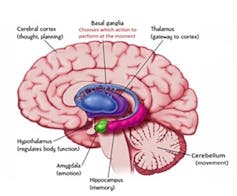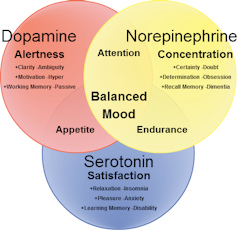“My brain has way too many tabs open.”
“Why can’t I complete tasks?”
“Why do I lose track of time?”
“Why can’t I pay attention?”
These are all questions that people with attention deficit hyperactivity disorder, or ADHD, may ask themselves daily, if not hourly.
As a primary care family nurse practitioner, I have diagnosed and treated many patients with ADHD. I was also diagnosed with ADHD at the age of 21.
Understanding how wiring differs in a brain with ADHD and what improves functioning is essential to helping those who struggle because of the uniqueness of their brains.
How do ADHD brains differ?
Research has identified multiple differences in how the brain functions in ADHD.
Simply put, ADHD significantly affects executive function.
Executive functioning is a set of cognitive processes, including planning, prioritization, impulse control, flexibility, time management, and emotional regulation, that help people achieve long-term goals.
These processes occur in the prefrontal cortex – the “personality center” – of the brain.
In addition to the prefrontal cortex, ADHD affects other areas of the brain, including the basal ganglia, an area that regulates communication within the brain, and the cerebellum, which is responsible for movement and balance. These three areas work together to regulate attention, executive function, motor activity, and impulse control.

Understanding Ali Saber, et al., CC BY
Chemical messengers called neurotransmitters allow brain cells to communicate with each other. Dopamine and norepinephrine are two key neurotransmitters that play a critical role in the brain’s executive functioning.
Dopamine controls motivation, rewards, and pleasure. We get a flood of dopamine from pleasurable activities like eating, drinking alcohol, having sex, and receiving positive affirmations or good grades. This flood also motivates us to repeat the “rewarding” behavior. Norepinephrine is responsible for maintaining attention and contributes to executive functioning.
People with ADHD have lower levels of dopamine and norepinephrine in certain regions of the brain, particularly in the prefrontal cortex. This leads to difficulties maintaining cognitive functions such as attention, impulse control, and motivation.
Studies show that people with ADHD have more dopamine transporters in their brains. Think of transporters as vacuum cleaners that suck dopamine into the neuron, making it less available.
As a result, there is less activation of dopamine and norepinephrine in the prefrontal cortex and the mesolimbic pathway, the area that processes rewards and motivation. Decreased dopamine may cause people to seek out stimulating rewards such as technology, food, or drugs.
Researchers have identified at least 27 possible genetic markers that modulate dopamine regulation in the brain.

Commons-logo.svg/Wikimedia Commons
Diagnosing ADHD
Almost everyone with or without ADHD has symptoms such as memory loss. For example, you can’t stand to sit in a meeting for a moment longer or you can’t remember why you entered a room.
A true diagnosis of ADHD takes several factors into account.
If you have ADHD, you have at least five to six symptoms in the inattentive, hyperactive, or impulsive categories, such as forgetfulness, difficulty sitting still, losing things, and being easily distracted.
For a formal diagnosis, ADHD symptoms must be present before age 12, which can be determined in childhood or, as in my case, much later.
Additionally, ADHD symptoms must negatively affect the person in multiple settings, such as at home, school, or work – and they cannot be explained by other conditions, such as thyroid dysfunction, diabetes, lack of sleep, or anemia.
Research shows that girls with ADHD are more likely to have symptoms of inattention as well as characteristics not traditionally associated with ADHD, such as shyness, perfectionism, and eating disorders. Patients, especially women and girls, may develop depression or anxiety—or both—as a result of untreated ADHD. Once ADHD is treated, symptoms of anxiety and depression are significantly reduced.
How ADHD Medications Alter Neurotransmitters
The American Academy of Pediatrics provides evidence-based guidelines for treating ADHD in children and adolescents.
The first U.S. guidelines for treating ADHD in adults are expected to be published in fall 2024.
If patients are 6 years of age or older, stimulant or non-stimulant medications may be used, along with behavioral therapy.
Stimulants are divided into two classes of drugs: amphetamines, such as Adderall and Vyvanse, and methylphenidates, such as Concerta, Ritalin, and Focalin.
Non-stimulants such as Strattera are recommended if patients cannot tolerate or prefer not to take stimulant medications.
Stimulants block dopamine and norepinephrine transporters, preventing them from depleting these neurotransmitters, so that more dopamine is available to activate key areas of the brain.
Amphetamines also increase the release of dopamine and norepinephrine from neurons. These increased levels allow the brain to find difficult tasks, such as doing homework, more rewarding. Because there is more dopamine available, the brain’s desire for stimulating rewards decreases.
Methylphenidates are generally the drug of choice for children, while amphetamines are more effective in adults.
Numerous studies have shown that stimulants improve ADHD symptoms, patient motivation, parent quality of life, and teacher behavioral ratings. Stimulants decrease anxiety and emotional dysregulation in children. Nonstimulants also improve ADHD symptoms.
Improved results
People with ADHD are twice as likely to attempt suicide as people without ADHD. They also have three times more suicidal thoughts and are six times more likely to complete suicide.
Treating patients with ADHD with stimulant medications, in addition to behavioral therapy, has been shown to reduce suicide attempts, unintended pregnancies, and substance use. One study found that treating children with ADHD with methylphenidate reduced their risk of burns by 57%.
In addition to medication, cognitive behavioral therapy for adults, executive function training, especially for adolescents, and positive parenting interventions have been shown to be effective for ADHD symptoms. Most researchers agree that behavioral training is most effective when combined with medication.
Positive parenting
Research has shown significant improvements in the quality of life of parents and children when parents participate in positive parenting. The effect is even more pronounced when combined with medication.
One such model, called the Nurtured Heart Approach, has been used by families, schools, foster care agencies and behavioral health groups, including the New Jersey Children’s System of Care. It emphasizes praise and encouragement, setting clear limits for acceptable behavior and teaching children to self-regulate their emotions and behaviors.
As a medical provider, I have seen such models work wonders in families and classrooms.
Food supplements
Several studies have shown that children with ADHD have lower levels of vitamin D in their bloodstream.
Having enough iron in the body, stored in the protein ferritin, is important for creating dopamine and norepinephrine, the neurotransmitters that are lacking in ADHD. Research has shown that low levels of ferritin cause disruption in dopamine activity. Children with lower levels are more likely to be diagnosed with ADHD.
This is why it is important for providers to check ferritin levels and not serum iron, which is often incorrectly used to diagnose iron deficiency.
Taking steps forward
If you think you or your child may have ADHD, talk to a healthcare professional who is knowledgeable about treating ADHD. For school accommodations, the first thing to do is talk to your healthcare professional.
Research is still ongoing, but high consumption of processed foods may worsen ADHD symptoms.
Pay attention to sleep; sleep apnea and sleep-disordered breathing are common in people with ADHD.
And be sure to get plenty of exercise, as this can improve executive functioning and impulse control while increasing dopamine and norepinephrine levels.
Although it’s overwhelming, I’m happy to say that living with ADHD can be rewarding.
ADHD has many advantages: we are resilient, unconventional and creative. We have intense energy that, when harnessed, can be used for good.